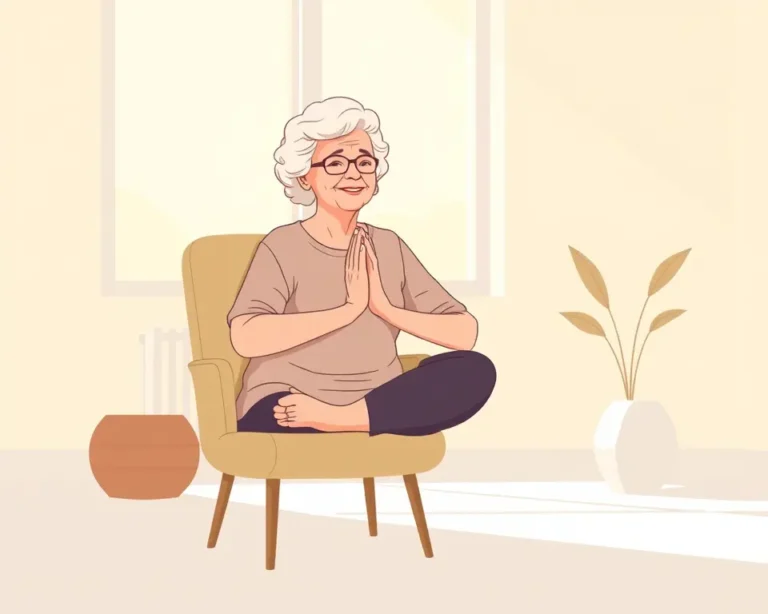Chair yoga is emerging as a revolutionary approach to senior fitness, offering a gentle yet effective path to improved health and well-being. This accessible practice allows older adults to experience the benefits of traditional yoga without the risks associated with complex poses or floor work. A 30-day chair yoga challenge can be a transformative experience, leading to increased flexibility, strength, and mental clarity.
Why Chair Yoga is a Game-Changer for Seniors
Traditional yoga, while beneficial, can be challenging for seniors due to mobility limitations or concerns about balance. Chair yoga modifies classic poses to be performed while seated or using a chair for support, making it accessible to individuals of all fitness levels. This adaptation eliminates the risk of falls and reduces strain on joints, allowing seniors to safely engage in a comprehensive exercise routine.
Dr. Emily Chen, a geriatric specialist, notes, “Chair yoga offers all the benefits of traditional yoga without the risk of falls or joint strain, making it perfect for seniors looking to improve their overall health.”
Benefits of Chair Yoga
- Low-Impact Workout: Chair yoga is easy on the joints, making it suitable for individuals with arthritis or other joint conditions.
- Increased Flexibility: Regular practice stretches and lengthens muscles, improving range of motion and easing daily activities.
- Improved Balance: Certain poses enhance stability and coordination, reducing the risk of falls.
- Enhanced Strength: Chair yoga builds muscle strength without the need for heavy weights.
- Stress Reduction: The practice incorporates breathing exercises and mindfulness, promoting relaxation and reducing stress levels.
- Improved Circulation: Gentle movements stimulate blood flow, improving circulation throughout the body.
- Mood Enhancement: As a mind-body exercise, yoga is known to boost mood and alleviate symptoms of depression and anxiety.
- Combats Depression and Anxiety: The combination of physical activity and mindfulness can have a positive impact on mental health.
- Improved Pain Management: Studies have shown that chair yoga can reduce joint pain and improve overall pain management.
- Promotes Independence and Wellbeing: Chair yoga can empower seniors to maintain their independence and improve their overall quality of life.
- Improved Cognitive Function: Some studies suggest that yoga can improve cognitive function and memory.
- Enhanced Sleep Quality: Regular exercise and stress reduction can lead to better sleep patterns.
- More Social Connections: Group chair yoga classes can provide opportunities for social interaction and community building.
- Accessibility: Chair yoga can be done virtually anywhere, making it a convenient and accessible form of exercise.
- Budget-Friendly Exercise: Chair yoga requires minimal equipment, making it an affordable option for seniors.
Preparing for the 30-Day Chair Yoga Challenge
Before embarking on the 30-day chair yoga challenge, it’s important to prepare both your body and your environment.
- Consult Your Doctor: Talk to your healthcare provider before starting any new exercise program, especially if you have underlying health conditions.
- Choose the Right Chair: Select a sturdy chair without arms that allows your feet to rest flat on the floor. Ensure the chair is stable and won’t slip or move during the exercises.
- Create a Safe Space: Find a quiet, well-lit area with enough room to move comfortably around the chair. Remove any obstacles that could cause tripping or falls.
- Wear Comfortable Clothing: Choose loose-fitting clothing that allows for a full range of motion.
- Gather Props (Optional): While not essential, yoga blocks, straps, and blankets can be used to modify poses and provide additional support.
The 30-Day Chair Yoga Challenge: A Week-by-Week Guide
This 30-day challenge is designed to gradually introduce you to the benefits of chair yoga. Each week focuses on different aspects of fitness, building strength, flexibility, and balance. Remember to listen to your body and modify poses as needed.
Week 1: Laying the Foundation
The first week focuses on gentle stretches and breathing exercises to establish a foundation for the rest of the challenge.
- Seated Mountain Pose (Tadasana): Sit tall in your chair with your feet flat on the floor, hip-width apart. Lengthen your spine, relax your shoulders, and breathe deeply. Hold for 5-10 breaths.
- Neck Stretches: Gently tilt your head to the right, bringing your ear towards your shoulder. Hold for 2-3 breaths, then repeat on the left side. Next, gently drop your chin towards your chest and hold for 2-3 breaths.
- Shoulder Rolls: Roll your shoulders forward for 5 repetitions, then backward for 5 repetitions.
- Seated Cat-Cow (Marjaryasana to Bitilasana): Inhale as you arch your back and lift your chest, then exhale as you round your spine and tuck your chin to your chest. Repeat for 5-10 breaths.
- Overhead Stretch: Begin in a seated position, facing forward with your arms down by your sides. Slowly raise your arms overhead, stretching towards the ceiling.
Week 2: Building Strength and Balance
This week introduces poses that challenge your strength and balance while remaining safe and supported.
- Chair Warrior I (Virabhadrasana I): Sit in your chair and turn your body to the right, bringing your right knee over your right ankle, keep your left leg extended behind you. Raise your arms overhead and hold for 5-10 breaths. Repeat on the left side.
- Chair Warrior II (Virabhadrasana II): From Warrior I, open your arms to the sides, keeping your shoulders relaxed. Gaze over your front hand and hold for 5-10 breaths. Repeat on the left side.
- Seated Twist (Bharadvajasana): Sit tall in your chair and twist your torso to the right, holding onto the back of the chair for support. Hold for 5-10 breaths, then repeat on the left side.
- Reverse Arm Hold: Begin this pose in a seated position with your back straight and apart from the back of the chair. Reach both arms behind you and try to clasp your hands together.
Week 3: Expanding Your Practice
Week three builds on the previous weeks, adding more challenging poses and variations.
- Chair Sun Salutations: Combine several poses in a flowing sequence, such as seated mountain pose, overhead stretch, seated forward fold, and seated backbend. Repeat for 5-10 rounds.
- Seated Forward Bend (Uttanasana): Sit with your knees touching and your feet on the floor. Slowly bend forward from your hips, reaching towards your feet. Hold for 5-10 breaths.
- Chair Pigeon Pose: Sit upright with your back away from the back of the chair and facing forward. Bring one ankle onto the opposite knee and gently press down on the raised knee.
- Eagle Arms: Sit upright in your chair and stretch your arms straight out in front of you. Cross your left arm over your right arm, and bend your elbows to bring your forearms together.
Week 4: Deepening Your Practice and Integration
The final week focuses on deepening your practice and integrating chair yoga into your daily life.
- Review and Refine: Revisit your favorite poses from the previous weeks, focusing on proper alignment and breath control.
- Explore Variations: Try different variations of the poses to challenge yourself further. For example, add a gentle backbend to seated mountain pose or twist deeper in the seated twist.
- Incorporate Mindfulness: Pay attention to your breath and body sensations throughout the practice. Let go of any distractions and focus on being present in the moment.
- Chair King Arthur’s Pose: Sit in your chair facing forward, with your feet flat on the floor. Reach down with your right hand to grasp your right ankle. Lift your ankle up toward your hip, while letting your knee drop toward the ground. Keep your torso tall, and breathe deeply as you gently stretch the front of your thigh.
Beyond the Challenge: Sustaining Your Practice
As the 30 days conclude, consider how to maintain your newfound vitality. Many seniors find that incorporating a comprehensive 30-day senior exercise plan can further boost mobility and overall health.
- Set Realistic Goals: Aim to practice chair yoga at least 2-3 times per week, gradually increasing the frequency and duration as you feel comfortable.
- Find a Class or Group: Consider joining a local chair yoga class or online community for support and motivation.
- Listen to Your Body: Pay attention to any pain or discomfort and modify poses as needed. Rest when you need to and don’t push yourself too hard.
- Make it a Habit: Incorporate chair yoga into your daily routine, such as practicing for 10-15 minutes each morning or evening.
- Be Patient and Persistent: It takes time to see results, so be patient and persistent with your practice. Celebrate your progress and enjoy the journey.
Margaret, 72, who completed the challenge, shares, “Chair yoga isn’t just exercise; it’s a journey of self-discovery and empowerment. I feel stronger, more balanced, and more confident in my daily activities.”
By embracing the 30-day chair yoga challenge, seniors can unlock a world of physical and mental well-being, transforming their golden years into a vibrant and active chapter of life.







